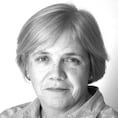Rachel Moss is an art historian and assistant professor in the Department of History of Art and Architecture in Trinity College, Dublin. She lives in Dublin with her husband, sculptor Jason Ellis
Catherine was my teacher when I studied art history in TCD. It was the late 1980s/early 1990s and the department at the time was very male and very patriarchal – she was the only female lecturer. We didn’t know it at the time but she was working three jobs and bringing up her two girls on her own. But she was the one who always had time for students. She was and is a brilliant lecturer: on occasion, her lectures would get spontaneous applause at the end, and that’s a very rare thing.
We became good friends after I left university through our mutual friend Rachel MacRory, who was a government policy adviser on architecture – Rachel and I had been at school and university together. She’d been a great support to Catherine, looking after her girls – Catherine had such a hectic life, racing around, on occasion she needed to rely on friends. So we all got to know each other well. And Betty, Catherine’s sister, and I were friendly.
Then Rachel, who had Cystic Fibrosis, died quite suddenly in 2002. I was the one to go up and tell Catherine: Rachel had been staying with me while her house was being done up in Dundrum. Everyone drew closer after that.
I always had a passion for the Medieval period. My grandfather, who lived in Sligo, was very interested in archaeology: I remember vividly when I was six and he took me to see a dig. One of the archaeologists put a human jawbone in my hand and told me about how you could tell she was a young woman.
Art history is seen as being a very elite discipline but Catherine and I would both be very strong on outreach. We've fought to make Art & Architecture of Ireland accessible: the plan is that when it's published digitally in a few years, every secondary school in the country will get a free copy.
Even though we’re doing quite different subjects for this project, Catherine and I bounced ideas off each other and swapped introductions. We were both working from home and it was quite a lonely thing to do, so it was nice sometimes just to stroll up the canal and meet for coffee.
Catherine’s a very warm and generous person, very wise. I’d take counsel from her.
Art and Architecture of Ireland, an illustrated five-volume work looking at 1,600 years of Irish art and architecture, from medieval to contemporary, is published by Yale University Press for the Royal Irish Academy and the Paul Mellon Centre. ria.ie/art-and-architecture-of-Ireland
Catherine Marshall is an art historian. After lecturing in Trinity College, Dublin, she became first head of collections at the Irish Museum of Modern Art. Originally from Kilkenny, she lives in Portobello
The first time Rachel really made an impression on me was when myself and Roger Stalley [former Trinity History of Art professor] took a group of students on a trip to Florence. Rachel, who was about 20, was already there on a year abroad and Roger suggested we get her to join us. I remember this girl who was very shy, who’d blush when teachers spoke to her – she was probably 20. But she had very well thought- out ideas, was very clear and strong in her thinking and I was very impressed by that.
And then there was another person who I think both of us would look on as one of the best friends we ever had. She was Rachel MacRory: she had come straight out of college to become architectural adviser in the Department of Arts and Heritage. She had Cystic Fibrosis and died suddenly in 2002 when she was still in her 30s, having achieved so much. Since Rachel’s death, the people who were her friends have got closer and closer to each other.
Another thing that brought us together was a shared social agenda: I’ve always had a strong interest in making the things I love best really accessible to people from every background – at IMMA we had great connections to local communities; Rachel [Moss] worked on literacy projects in Fatima Mansions while she was a postgraduate student.
We’d meet at dinner parties in each others’ houses, at Rachel MacRory’s flat, and with my older sister, who was very friendly with Rachel [Moss]. Betty studied History of Art as a mature student, was in Rachel’s year and was also a Medievalist.
I approach art history from a very strong feminist point of view and I think Rachel does too. It would be very much about . . . about making sure that women who did achieve extraordinary things are properly identified and documented. It’s only very latterly that that has happened.
I’d always drawn and painted: my grandfather, Denis J Gorey, was a TD in the 1930s and 1940s who used to sketch the other TDs in the Dáil. I came from Kilkenny to study art history in UCD in Dublin in the 1960s, then taught in the inner city and I went on to do a History of Art degree in Trinity. I taught there from then on.
When I was writing the intro to my volume I wanted to run it past somebody else. The person I chose who I thought had the integrity, an understanding of all the issues, and courage, was Rachel.
Rachel is kind and very honest and willing to fight fiercely for causes that she believes in. She is full of integrity, and much more tactful than I am. And definitely less shy than she was.








